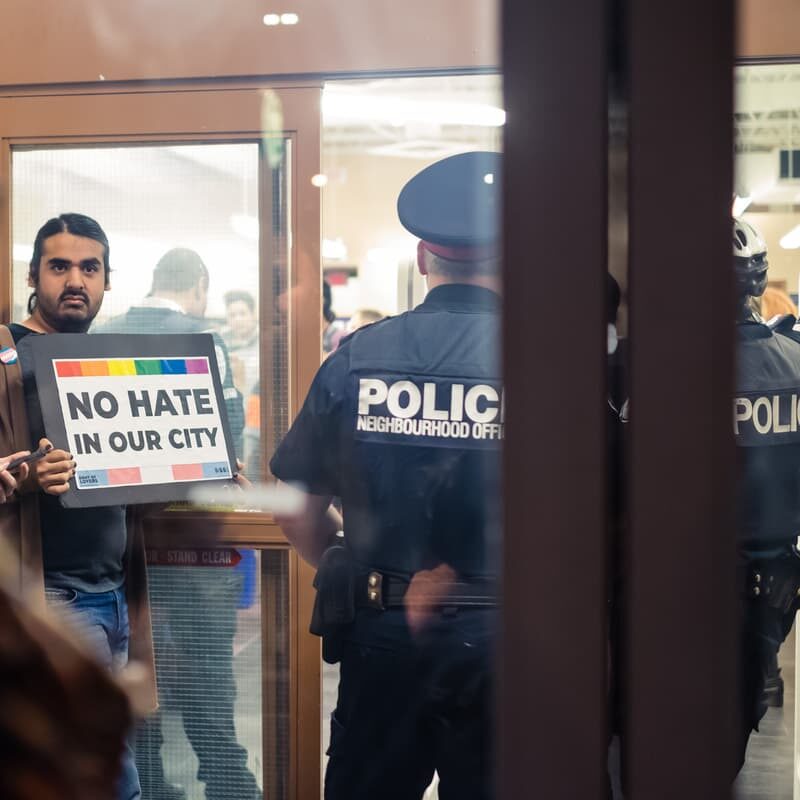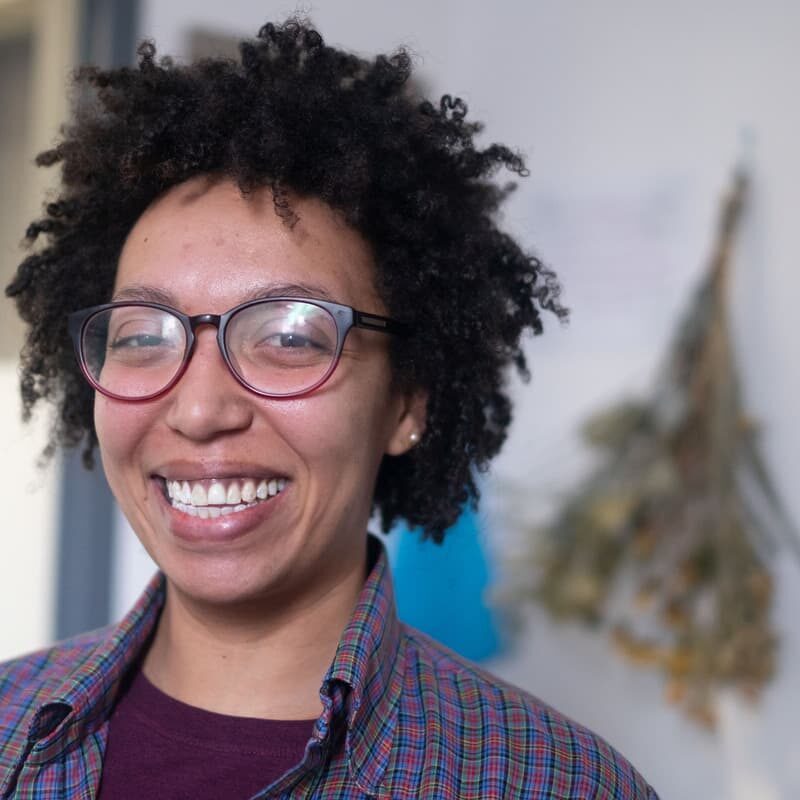Focus on: Crime, Violence, and the Law
Best practices for reporting on trans and gender-diverse folks who are victims of crime or who may benefit from trauma-informed reporting techniques. Additionally, positioning the role of journalism in bringing public attention to community safety concerns raised by 2SLGBTQ+ community members.

Introduction
When trans and gender-diverse communities are covered in the mainstream media, it’s often for reasons no one wants: the loss of loved ones, discrimination, experiences of hate-based violence, or because someone has decided it’s appropriate to deny our existence and fuel bigoted rhetoric.
By The Numbers
68% of trans and non-binary people in Canada report having been verbally harassed in the last five years.
9 out of 10 racialized trans and non-binary people anticipate unfair treatment from the police and legal system if they were to be sexually assaulted.
41% of trans people in Canada have experienced unwanted sexual behaviour online, compared to 16% of cisgender Canadians.
Raising the Red Flag
The media plays a vital role in drawing attention to violence committed against 2SLGBTQ+ communities. Crimes affecting trans and non-binary communities are often under-investigated or ignored by the institutions that are responsible for protecting everyone equally.
The role of media in raising the red flag was evident in the arrest and eventual guilty plea of Bruce McArthur on eight counts of first-degree murder in 2019. 2SLGBTQ+ folks in Toronto had long been sounding the alarm bell around the disappearance of people in the community—including to the media. The fact that these horrible, violent losses remained uninvestigated and unseen for so many years is an inconceivable tragedy.
These missing person investigations and others in relation to 2SLGBTQ+ and vulnerable or marginalized communities were the focus of an independent review led by Justice Gloria Epstein. The report points to “systemic discrimination” and “institutional resistance” within the Toronto Police Service as reasons why investigations failed to link the missing persons cases and realize a serial killer was preying on Toronto’s 2SLGBTQ+ communities.
It was only after one of McArthur’s victims, Andrew Kinsman, went missing that the Toronto Police Service initiated Project Prism, which led to the eventual arrest of McArthur in 2018. Alongside pressure from the public and those close to Kinsman, Justice Epstein credits media coverage for finally launching the investigation.
Journalists have the power to amplify the calls of community members whose voices may otherwise go unheard. You can scrutinize claims the system has failed to investigate. And you can interview community members to paint a fuller picture about how someone was a whole and complex individual.
We remember Kirushna Kumar Kanagaratnam, Majeed Kayhan, Skandaraj (Skanda) Navaratnam, Abdulbasir Faizi, Selim Esen, Soroush Mahmudi, Dean Lisowick, Andrew Kinsman, Alloura Wells, Tess Richey, and all those for whom justice is still being sought.
Reporting on Trans Victims of Crime
When violent crimes occur, police news releases are the most common source of information for news reports. Unfortunately, this information is not always correct or complete. These are challenging situations with no easy solution. But there are ways to ensure your reporting treats transgender victims of violent crime with dignity, fairness, respect, and care.
Common Errors
Error #1: Misgendering
A person has been misgendered on a police news release
Police news releases always state the gender of a missing person or the perpetrator of a crime—this is done using binary sex assignments of male or female. This may disrespect and misrepresent a person’s gender identity and constitutes uninterrogated assigning of gender without a person’s consent. Sometimes a person’s gender identity is assumed based on how they were presenting in the moment, or what is on their ID card.
In the case of deaths, police will often gender a victim based on their anatomy or forensic evidence. Neither are a true representation of a person's gender identity. This can also make it difficult for loved ones to accurately locate or share information after a violent crime or death.
Suggested actions for better reporting
We understand the fast turnaround time between press conferences and newsroom deadlines. For these news hits, there isn’t much you can do by way of fact checking the information reported in a police news release.
Instead, consider paraphrasing a news release or leaving out information that may be inaccurate. Including the word “appeared” or “presented” can suggest that there are details regarding a person’s gender identity that are yet to be confirmed.
For example: “Hamilton Police say the suspect was presenting as a man when he fled the scene.” Or “Hamilton Police say the victim appears to be a woman in her mid-40s.”
If you have time before submitting a story, check a person’s social media profile or talk to any community members who might be present at the press conference. Both take only a few minutes and could help you correctly identify a person’s gender identity and engage in more dignified reporting.
Reporting Do’s
Ensure you have informed consent before starting an interview.
Ask open-ended questions and be prepared to take an interview where someone wants it to go.
Weigh the cost of asking a question against your editorial need for details. Getting into the specifics of a traumatizing event to add drama to your story is not enough of a reason to make someone relive a difficult memory.
Be in service to the individual and their experience, and report stories in a way that centres their humanity and personhood.
Reporting Dont’s
Focus only on a narrative of pain and suffering.
Pressure someone for details if they can’t remember. It is common for survivors of traumatic and violent events to experience memory loss.
Pose questions in a way that might make a person feel blamed, shamed, or somehow responsible for the violence they experienced.
“If somebody was talking about one of your most difficult moments in life, is that all you would want them to see? It doesn’t dilute a story to also bring out something that makes someone more whole and complex.”
- Jaymie Sampa (she/her, they/them), Director, Strategic Partnership Initiatives at The 519


Other Reporting Tips
Explain what a person can expect from an interview, including the questions and how their story will be used
Position your interest in their experience and story. Ask why they want to tell their story to help frame your narrative and any calls to action
Discuss the way in which someone can pause or end an interview if they’re feeling uncomfortable at any point, without consequence to them
Ask someone if there’s a space where they feel safer talking
Encourage them to bring a safe and trusted person with them (e.g. a friend, family member, or caseworker) to an interview for support
Ease into asking your most sensitive, personal questions
End an interview by bringing people back to the present moment. For example, ask “What comes next for you now?” or “What’s something you’re looking forward to?”
Further Context
The following sections provide further context for reporting as it relates to the experiences of 2SLGBTQ+ Communities with crime, violence & the law.
Resources
Trauma Informed Reporting
An insightful guide written by journalist Alice Wilder that covers responsible interviewing techniques and more.
Doubly Victimized: Reporting on Transgender Victims of Crime
Thorough guidelines to ensure that trans victims of violent crimes are treated respectfully and fairly.
Visit website
Open Doubly Victimized: Reporting on Transgender Victims of Crime in a new tab
Missing and Missed Reports, Volumes 1-4
Justice Gloria Epstein’s review and recommendations evaluating how the Toronto Police Service conducts missing person investigations, particularly in relation to 2SLGBTQ+ communities.
Visit website
Open Missing and Missed Reports, Volumes 1-4 in a new tab
Still have questions? Connect with us.
Get in touch with our media relations team, book an education and training session, or flag a story that shows what good reporting looks like in action.